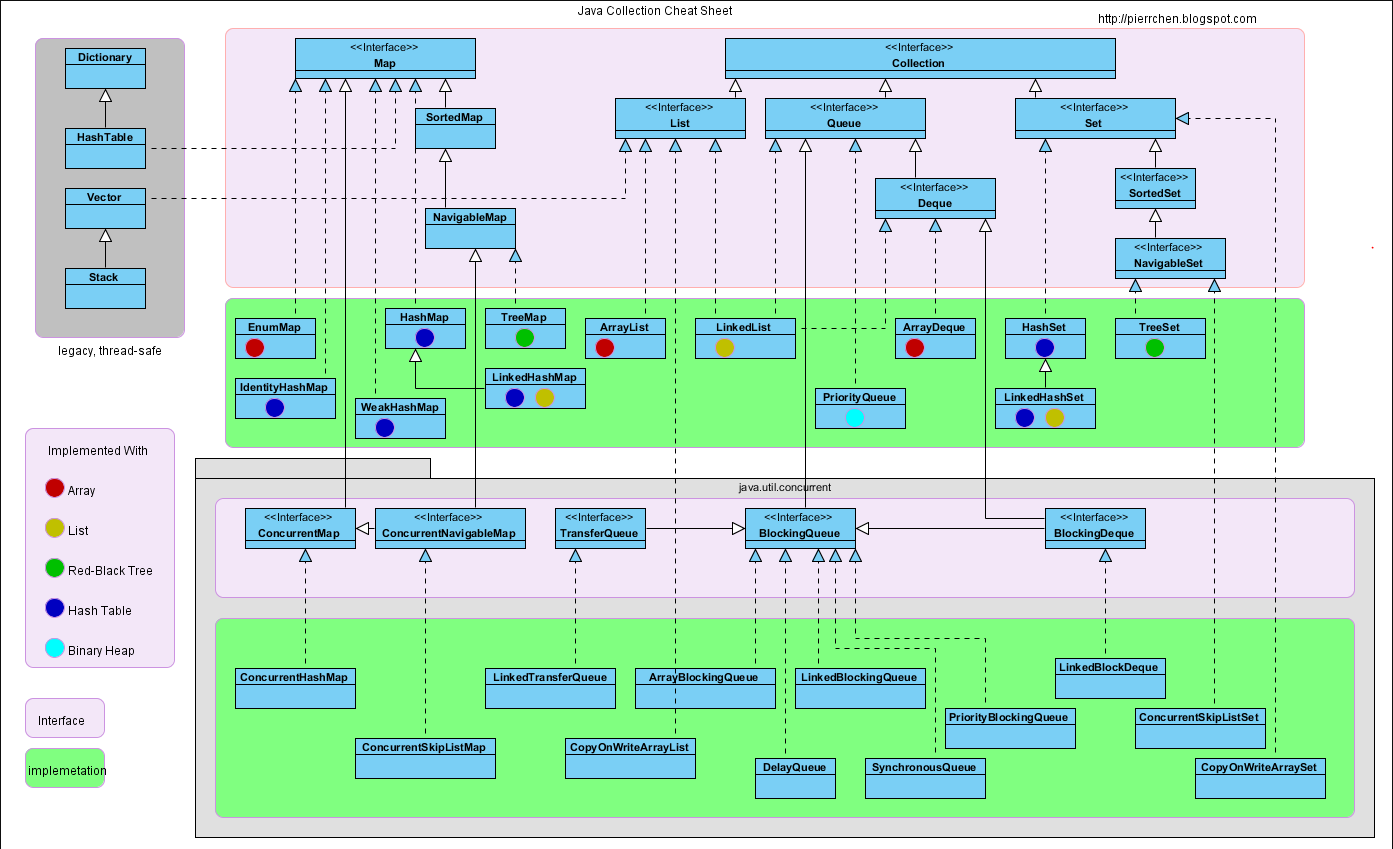接下来的一段时间重点介绍java.util这个包中的内容,这个包厉害了,包含了collection与map,提供了集合、队列、映射等实现。一张图了解java中的集合类:

AbstractList
一、list简介
list是啥?为啥会有list的存在呢?java中的数组相信大家都是非常熟悉的,可以存放多个数据,但是数组有一个缺点,就是数组在创建之后,长度就不可更改(但是针对于数组的元素可以更改),若你需要在后续过程中往数组中添加数据,那麻烦了,不支持。
list在java中是collection(集合)的子接口,运行过程中可以增加元素或是减少元素。List里存放的对象是有序的(有序不是指按照元素的大小排列,是按照元素添加顺序为维度的,例如第一个被添加的元素,get的时候就第一个被拿出来),同时也是可以重复的。
二、AbstractList类定义
public abstract class AbstractList<E> extends AbstractCollection<E> implements List<E> protected AbstractList() {}
成员变量:
//代表修改次数 protected transient int modCount = 0;
三、主要方法
1、add()、addAll()
//把一个元素加进list public boolean add(E e) { //当然是调用指定index的方法,传入size,还有元素即可,假设一共5个元素,那么下标5一定是空的喽 add(size(), e); return true; } //由各子类实现 public void add(int index, E element) { throw new UnsupportedOperationException(); }
public boolean addAll(int index, Collection<? extends E> c) { //校验index是否<0或>list.size() rangeCheckForAdd(index); boolean modified = false; for (E e : c) { //循环添加元素 add(index++, e); modified = true; } return modified; }
2、get()、set()、remove()
//都是由子类实现 //获取对应索引位的元素 abstract public E get(int index); //更改给定索引位的元素 public E set(int index, E element) { throw new UnsupportedOperationException(); } //根据某个索引删除该索引位的元素 public E remove(int index) { throw new UnsupportedOperationException(); }
3、indexOf()、lastIndexOf()
public int indexOf(Object o) { //使用listIterator迭代器 ListIterator<E> it = listIterator(); if (o==null) { while (it.hasNext()) //在执行next()方法时,取的是当前对象,并且cursor+1,可以看后面内部类的介绍 if (it.next()==null) //由于cursor+1,所以要取前一个索引值 return it.previousIndex(); } else { while (it.hasNext()) //如果元素不为null的话,使用equals()进行比较。因为null.equals()会报空指针 if (o.equals(it.next())) return it.previousIndex(); } //若list没有此元素,则返回-1 return -1; } //倒着循环list,就ok了 public int lastIndexOf(Object o) { ListIterator<E> it = listIterator(size()); if (o==null) { while (it.hasPrevious()) if (it.previous()==null) return it.nextIndex(); } else { while (it.hasPrevious()) if (o.equals(it.previous())) return it.nextIndex(); } return -1; }
4、clear()
//清空整个list public void clear() { removeRange(0, size()); } //将fromIndex到toIndex范围内的元素全干掉 protected void removeRange(int fromIndex, int toIndex) { ListIterator<E> it = listIterator(fromIndex); for (int i=0, n=toIndex-fromIndex; i<n; i++) { it.next(); it.remove(); } }
5、subList()
public List<E> subList(int fromIndex, int toIndex) { return (this instanceof RandomAccess ? new RandomAccessSubList<>(this, fromIndex, toIndex) : new SubList<>(this, fromIndex, toIndex)); }
6、equals()、hashCode()
public boolean equals(Object o) { if (o == this) return true; if (!(o instanceof List)) return false; ListIterator<E> e1 = listIterator(); ListIterator<?> e2 = ((List<?>) o).listIterator(); while (e1.hasNext() && e2.hasNext()) { E o1 = e1.next(); Object o2 = e2.next(); //比较的逻辑就在这了,如果都为null,就相等,否则就equals比较 if (!(o1==null ? o2==null : o1.equals(o2))) return false; } //这地方也很好理解,比如两个list,一个5个长度,一个6个长度,并且前5个元素都相等,前面的玄幻已经干完5个元素的比较了。那就判断是否还有下一个,就可以得出他们长度是否相等了 return !(e1.hasNext() || e2.hasNext()); }
public int hashCode() { int hashCode = 1; for (E e : this) //为啥乘以31?31是质子数中一个“不大不小”的存在,如果你使用的是一个如2的较小质数,那么得出的乘积会在一个很小的范围,很容易造成哈希值的冲突。而如果选择一个100以上的质数,得出的哈希值会超出int的最大范围,这两种都不合适。
而如果对超过 50,000 个英文单词(由两个不同版本的 Unix 字典合并而成)进行 hash code 运算,并使用常数 31, 33, 37, 39 和 41 作为乘子,每个常数算出的哈希值冲突数都小于7个(国外大神做的测试),那么这几个数就被作为生成hashCode值得备选乘数了。 hashCode = 31*hashCode + (e==null ? 0 : e.hashCode()); return hashCode; }
四、迭代器Iterator
迭代器是什么东西呢?为啥循环list的时候需要用到它?其实原因也很简单,迭代器其实是一种设计模式,在java中,list的实现有很多种,例如数组列表(ArrayList)、链表结构的(LinkedList)等等。那么循环这些不同数据结构的list就要命了,因此呢,使用Iterator封装循环获取list的方法,它可以遍历并选择序列中的对象,而开发人员不需要了解该序列的底层结构。
1、iterator()、listIterator()
上面的代码中经常出现listIterator()方法
//Itr以及ListItr是两个内部类 public Iterator<E> iterator() { return new Itr(); } public ListIterator<E> listIterator() { return listIterator(0); } public ListIterator<E> listIterator(final int index) { //检查索引是否<0或>list.size rangeCheckForAdd(index); return new ListItr(index); }
2、Itr
private class Itr implements Iterator<E> { //在调用next()之后,cursor+1(因为最终cursor与size做比较的,cursor=index+1)随后返回的下标 int cursor = 0; //调用next、previous,都会更新该下标值,当调用remove元素,就会重置为-1,代表最后返回的元素下标 int lastRet = -1; ////将Abstract修改次数赋值给预期次数 int expectedModCount = modCount; //看到这里就好理解上面了,cursor比较的是size。例如list有5个元素,size为5,index为0-4 public boolean hasNext() { return cursor != size(); } public E next() { //检查修改次数 checkForComodification(); try { int i = cursor; //获取当前元素 E next = get(i); //设置为当前索引 lastRet = i; //获取到当前元素之后,cursor=cursor+1 cursor = i + 1; return next; } catch (IndexOutOfBoundsException e) { checkForComodification(); throw new NoSuchElementException(); } } public void remove() { if (lastRet < 0) throw new IllegalStateException(); checkForComodification(); try { //内部类调用外部类的方法,类名.this.xxx(),删除的是next()调用时的元素 AbstractList.this.remove(lastRet); if (lastRet < cursor) //删除了一个元素,cursor自然要-1 cursor--; //将lastRet重置为-1 lastRet = -1; expectedModCount = modCount; } catch (IndexOutOfBoundsException e) { throw new ConcurrentModificationException(); } } final void checkForComodification() { if (modCount != expectedModCount) throw new ConcurrentModificationException(); } }
3、ListItr
//这玩意扩展了Itr,可以倒着循环 private class ListItr extends Itr implements ListIterator<E> { ListItr(int index) { //这里面的cursor就等于index。跟Itr不同 cursor = index; } public boolean hasPrevious() { return cursor != 0; } public E previous() { checkForComodification(); try { //取前一个元素,这里的cursor跟index一致。当前index-1 int i = cursor - 1; E previous = get(i); lastRet = cursor = i; return previous; } catch (IndexOutOfBoundsException e) { checkForComodification(); throw new NoSuchElementException(); } } //其实就是获取当前元素的下标 public int nextIndex() { return cursor; } //获取前一个元素的下标 public int previousIndex() { return cursor-1; } public void set(E e) { if (lastRet < 0) throw new IllegalStateException(); checkForComodification(); try { AbstractList.this.set(lastRet, e); expectedModCount = modCount; } catch (IndexOutOfBoundsException ex) { throw new ConcurrentModificationException(); } } public void add(E e) { checkForComodification(); try { int i = cursor; AbstractList.this.add(i, e); //添加元素也将lastRet设为-1 lastRet = -1; cursor = i + 1; expectedModCount = modCount; } catch (IndexOutOfBoundsException ex) { throw new ConcurrentModificationException(); } } }
为啥先介绍AbstractList?因为后面的重点ArrayList以及LinkedList都是他的子类,所以后面学起来就能串起来了,毕竟用了很多父类的功能。